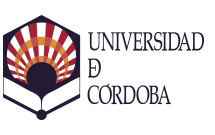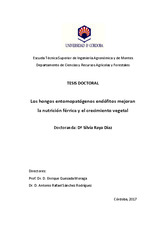Los hongos entomopatógenos endófitos mejoran la nutrición férrica y el crecimiento vegetal
Autor
Raya Díaz, Silvia
Director/es
Quesada-Moraga, EnriqueSánchez Rodríguez, Antonio Rafael
Editor
Universidad de Córdoba, UCOPressFecha
2018Materia
EndófitoRizosfera
Clorosis férrica
Método de inoculación
Longitud raíz
Metarhizium brunneum
Beauveria bassiana
Isaria farinosa
Spodoptera littoralis
Sorgo
Girasol
Trigo
Endophyte
Rhizosphere
Iron chlorosis
Inoculation method
Root length
Sorghum
Sunflower
Wheat
METS:
Mostrar el registro METSPREMIS:
Mostrar el registro PREMISMetadatos
Mostrar el registro completo del ítemResumen
Los ascomicetos mitospóricos entomopatógenos (AME) son un
componente importante de la microbiota de los ecosistemas naturales,
agrícolas y forestales, donde regulan las poblaciones de insectos y ácaros
fitófagos, pero además, pueden ser utilizados de forma deliberada para el
control de plagas de acuerdo con distintas estrategias, incluso de forma
inundativa, como micoinsecticidas. Más allá, trabajos llevados a cabo
principalmente en la última década resaltan que la función ecológica de los
AME sobrepasa su condición de entomopatógenos, pues sus
sorprendentes relaciones con las plantas, como endófitos, en el filoplano o
en la rizosfera, abren nuevos horizontes en la protección y producción
vegetal. Los resultados de esta tesis doctoral ponen de manifiesto los
beneficios asociados al carácter endófito y competente en la rizosfera de
cepas de AME, principalmente de los géneros Beauveria y Metarhizium,
sobre distintas plantas cultivadas, no sólo por su impacto en el control de
plagas, sino también sobre su crecimiento y nutrición férrica en suelos
calcáreos. The entomopathogenic mitosporic ascomycetes (EMA) are an important
component of the microbiota of natural, agricultural and forest
ecosystems, where they regulate insect populations and phytophagous
mites, but can also be used deliberately for the control of pests in
accordance with different strategies, including inundative release as
mycoinsecticides. Furthermore, works carried out mainly in the last decade
highlight that the ecological role of EMAs exceeds their status as
entomopathogens, because of their surprising associations with plants, as
endophytes, in the phylloplane or in the rhizosphere, open new horizons in
Plant protection and Production. The results of this Doctoral Thesis show
the benefits associated with the endophytic and rhizosphere competent
behavior of strains of EMA, mainly of the genera Beauveria and
Metarhizium, on different cultivated plants, not only for their impact on
the control of pests, but also about its growth and ferric nutrition in
calcareous soils.

